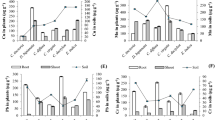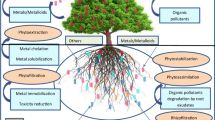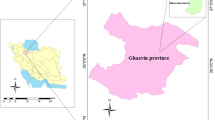Abstract
Phytoremediation is the use of plants and their associated microorganisms, to remove or degrade biochemically the pollutants from the soil and groundwater environment. It is an emerging technology for water/soil/agricultural remediation, which offers a low-cost flexible technique suitable for use against a number of different types of contaminants in a variety of media. This research illustrates that this technology can be used to reduce the concentration of pollutants in Kuwait shallow groundwater to improve the efficiency of irrigation for greenery purposes. The investigation of this research was carried out through using reed plants in two experiments: First in decaying reed leaves and the second in reed roots. The change in the concentration of the inflow of the polluted groundwater and the outflow of the treated irrigation water was measured in the laboratory for chemical analysis. The two experiments indicated the ability of the reed plants to reduce the concentration of salt ions (Cl, Na, K, and SO4) by about 66–78%. Roots reduced the total dissolved solid values by 66%, the plants were capable of reducing the concentration of nitrogen compounds significantly, and fluoride was reduced by ≈ 86% while the roots removed the lithium significantly. This research illustrates that the roots of the reed plants are capable to reduce the heavy metals of Cd, Co, Zn, and Fe significantly. The reduction of Al, Cu, and Cr by the roots of the reed plants was 53%, 39%, and 89% respectively. These results provide a preliminary indication that reed plants have the capability to remove pollutants at various levels and that salinity can be reduced considerably to improve irrigation efficiency in Kuwait.





Similar content being viewed by others
References
Afzal M, Khan MQ, Sessitsch A (2014) Endophytic bacteria: prospects and applications for the phytoremediation of organic pollutants. Chemosphere 117:232–242. https://doi.org/10.1016/j.chemosphere.2014.06.078
Ahmadpour P, Ahmadpour F, Sadeqhi SM, Tayefeh FH, Soleiman M, Abdu AB (2015) Evaluation of four plant species for phytoremediation of copper-contaminated soil. In: Hakeem KR, Sabir M, Öztürk M, Mermut AR (eds) Soil remediation and plants. Academic Press/Elsevier, New York, pp 147–205. https://doi.org/10.1016/B978-0-12-799937-1.00007-3
Akber A, Mukhopadhyay A, Al-Awadi E, Al-Qallaf H, Al-Haddad A, Azraq E, Bhandary H (2006) Investigation of distribution of nitrogen compounds in the groundwater of Kuwait. Kuwait Institute for Scientific Research. Final report No. 8165
Aliewi AS, Al-Khatib IA (2015) Hazard and risk assessment of pollution on the groundwater resources and residents’ health of Salfit District, Palestine. J Hydrol Reg Stud 4:472–486. https://doi.org/10.1016/j.ejrh.2015.07.006
Almansoory FA, Abu Hasan H, Idris M, Sheikh Abdullah SR, Anuar N (2015) Potential application of a biosurfactant in phytoremediation technology for treatment of gasoline-contaminated soil. Ecol Eng 84:113–120. https://doi.org/10.1016/j.ecoleng.2015.08.001
Al-Thyabat S, Nakamura T, Shibata E, Iizuka A (2013) Adaptation of minerals processing operations for lithium-ion (LiBs) and nickel metal hydride (NiMH) batteries recycling critical review. Miner Eng 45:4–17
American Public Health Association (APHA) (2015) Standards methods for the examination of water and wastewater, 20th edn. In: Clesceri LS, Greenberg AE, Eaten AD. American Health Association, American Water Works Association and American Environment Federation, Washington, DC
Anderson MA, Bertsch PM, Miller WP (1988) The distribution of lithium in selected soils and surface waters of the southeastern USA. Appl Geochem 3(2):205–212
Antonkiewicz J, Jasiewicz C, Koncewicz-Baran M, Bączek-Kwinta R (2017) Determination of lithium bioretention by maize under hydroponic conditions. Arch Environ Prot 43(4):94–104. https://doi.org/10.1515/aep-2017-0036
Athar R, Ahmad M (2002) Heavy metal toxicity: effect on plant growth and metal uptake by wheat, and on free living Azotobacter. Water Air Soil Pollut 138(1):165–180. https://doi.org/10.1023/A:1015594815016
Black H (1995) Absorbing possibilities: phytoremediation. Environ Health Perspect 103(12):1106–1108
Caicedo JR, Van der Steen NP, Arce O, Gijzen HJ (2000) Effect of total ammonia nitrogen concentration and pH on growth rates of duckweed (Spirodela polyrrhiza). Water Res 34(15):3829–3835
Carman EP, Crossman TL (2000) Phytoremediation. In: Nayer EK, Palmer PL, Carman EP, Boetttcher G, Bedessem JM, Lenzo F, Crossman TL, Rorech GJ, Kidd DF (eds) In situ treatment technology. Lewis Publishers, FL, pp 391–435
Chappell J (1998) Phytoremediation of TCE in groundwater using Populus, vol 1998. EPA, USA
Dhanwal P, Kumar A, Dudeja S, Chhokar V, Beniwal V (2017) Recent advances in phytoremediation technology. Adv Environ Biotechnol 227–241. https://doi.org/10.1007/978-981-10-4041-2_14
Doni S, Macci C, Peruzzi E, Iannelli R, Masciandaro G (2015) Heavy metal distribution in a sediment phytoremediation system at pilot scale. Econ Eng 81:146–157. https://doi.org/10.1016/j.ecoleng.2015.04.049
Esetlili BC, Esetlili MT, Ozen, Bolca M, Kurucu Y (2014) Determination of arsenic pollution due to geothermal sources in agricultural lands of Alangulla-Aydin. Internation Medical Conference, MED-Env
Filippis LFD (2015) Role of phytoremediation in radioactive waste treatment. In: Hakeem K, Sabir M, Ozturk M, Mermut AR (eds) Soil remediation and plants: prospects and challenges. Academic Press, Elsevier, New York, pp 207–254
Gerhardt KE, Gerwing PD, Greenberg BM (2017) Opinion: Taking phytoremediation from proven technology to accepted practice. Plant Sci 256:170–185
Hachiya T, Sakakibara H (2017) Interaction between nitrate and ammonium in their uptake, allocation, assimilation and signaling in plants. J Exp Bot 68(10):2501–2512. https://doi.org/10.1093/jxb/erw449
Hull SL, Oty UV, Mayes WM (2014) Rapid recovery of benthic invertebrates downstream of hyper-alkaline steel slag discharges. Hydrobiologia 736:83–97
Kamusoko R, Jingura RM (2017) Utility of Jatropha for phytoremediation of heavy metals and emerging contaminants of water resources: a review. Clean Soil Air Water 45(11):100444. https://doi.org/10.1002/clen.201700444
Kim KR, Owens G (2010) Potential for enhanced phytoremediation of landfills using biosolids - a review. J Environ Manag 91:791–797. https://doi.org/10.1016/j.jenvman.2009.10.017
Kiraly KA, Pilinszky K, Bittsanszky A, Gyulai G, Komives T (2013) Importance of Ammonia detoxification by plants in phytoremediation and aquaponics. In: Proceedings of the 12th Alps-Adria Scientific Workshop Opatija, Doberdò, Venezia, Croatia, Italy, p 99–103. https://doi.org/10.12666/Novenyterm.62.2013.suppl
Klimek B, Sitarz A, Choczyriski M, Niklinska M (2016) The effects of heavy metals and total petroleum hydrocarbons on soil bacteria activity and functional diversity in Upper Silesis industrial region (Poland). Water Air Soil Pollut 227:265. https://doi.org/10.1007/s11270-016-2966-0
Kołodziej B, Antonkiewicz J, Stachyra M, Bielińska EJ, Wiśniewski J, Luchowska K, Kwiatkowski C (2015) Use of sewage sludge in bioenergy production – a case study on the effects on sorghum biomass production. Eur J Agron 69:63–74. https://doi.org/10.1016/j.eja.2015.06.004
Komorowicz I, Baralkiewicz D (2016) Determination of total arsenic and arsenic species in drinking water, surface water, wastewater, and snow from Wielkopolska, Kujawy-Pomerania, and Lower Silesia provinces, Poland. Environ Monit Assess 188(9):504
Lakra KC, Lal B, Banerjee TK (2017) Decontamination of coalmine effluent generated at the Rajrappa coalmine using phytoremediation technology. Int J Phytoremediation 19(6):530–536. https://doi.org/10.1080/15226514.2016.1267698
Ma H, Wang A, Zang M, Li H, Du S, Bai L, Chem S (2018) Compared the physiological response of two petroleum tolerant-contrasting plants to petroleum stress. Int J Phytoremdiation 20(10):1043–1048. https://doi.org/10.1080/15226514.2018.1460303
Mahar A, Wang P, Ali A, Awasthi MK, Lahori AH, Wang Q, Li R, Zhang Z (2016) Challenges and opportunities in the phytoremediation of heavy metals contaminated soils: a review. Ecotoxicol Environ Saf 126:111–121. https://doi.org/10.1016/j.ecoenv.2015.12.023
Mohan A, Girdhar M, Rehman H, Kumar A, Saggu S, Ansari AA (2015) Metal accumulation capability of weeds and their utilization in phytoremediation technology. In: Ansari AA., Gill SS, Gill R, Lanza GR, Lee N (eds) Phytoremediation: management of environmental contaminants, volume 2. Springer, p 343–357
Ogoko EC (2014) Evaluation of polycyclic aromatic hydrocarbons, total petoreum hydrocarbons and some heavy metals in soils of Nnpc Oil Depot Aba Metropolis, Abia State, Nigeria. J Environ Sci 8(5):21–27
Padmavathiamma P, Li L (2007) Phytoremediation technology: hyper-accumulation of metals in plants. Water Soil Pollut 184:105–126. https://doi.org/10.1007/s11270-007-9401-5
Raskin I, Burt D (2000) Ensley (ed) Phytoremediation of toxic metals: using plants to clean up the environment
Rowe DR, Abdel-Magid IM (1995) Handbook of wastewater reclamation and reuse. CRC Press, Inc., p 550
Schnoor JL, Licht LA, McCutcheon SC, Wolfe NL, Carreira LH (1995) Phytoremediation of organic and nutrient contaminants. Environ Sci 29(7):318–324
Shahid SA, Omar SA (1999) Order 1 soil survey of the demonstration farm sites with proposed management. Report no. 144. Kuwait Institute for Scientific Research
Shahzad B, Tanveer M, Hassan W, Shah AN, Anjum SA (2016) Cheema SA, Ali I, Lithium toxicity in plants: reasons, mechanisms and remediation possibilities - a review. Plant Physiol Biochem (107):104–115; https://doi.org/10.1016/j.plaphy.2016.05.034
Singh T, Singh DK (2017) Phytoremediation of organochlorine pesticides: concept, method, and recent developments. Int J Phytoremediation 19(9):834–843. https://doi.org/10.1080/15226514.2017.1290579
Smith S (1997) Phytoremediation: using plants to remediate soil and groundwater contamination. Brigham Young University, Utah
Swarup D, Dwivedi SK (2002) Environmental pollution and effects of lead and fluoride on animal. Health. Indian Council of Agricultural Research, Pusa
Van Deuren J, Lloyd T, Chhetry S, Liou R, Pec J (2002) Remediation Technologies Screening Matrix and Reference Guide. Federal Remediation Technologies Roundtable (FRTR) web site, www.frtr.gov
Wan X, Lei M, Chen T (2016) Cost–benefit calculation of phytoremediation technology for heavy-metal-contaminated soil. Sci Total Environ 563:796–802. https://doi.org/10.1016/j.scitotenv.2015.12.080
Wu C, Zhang X, Deng Y (2017) Review in Strengthening Technology for Phytoremediation of Soil Contaminated by Heavy Metals. IOP Conference Series. Earth Environ Sci 78(1):012015
Acknowledgements
The authors would like to thank Kuwait Institute for Scientific Research (KISR) for supporting technically and financially this research. KISR’s efforts are very much appreciated.
Author information
Authors and Affiliations
Corresponding author
Additional information
Responsible editor: Elena Maestri
Rights and permissions
About this article
Cite this article
Burezq, H., Aliewi, A. Using phytoremediation by decaying leaves and roots of reed (Phragmites austrates) plant uptake to treat polluted shallow groundwater in Kuwait. Environ Sci Pollut Res 25, 34570–34582 (2018). https://doi.org/10.1007/s11356-018-3385-0
Received:
Accepted:
Published:
Issue Date:
DOI: https://doi.org/10.1007/s11356-018-3385-0




